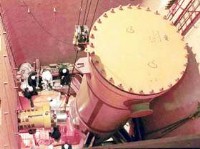 China’s first high-temperature, gas-cooled nuclear reactor was ignited in Beijing Thursday, December 21, showing that the country has made vital progress towards easing the energy shortage in the next century and maintaining nuclear safety.
China’s first high-temperature, gas-cooled nuclear reactor was ignited in Beijing Thursday, December 21, showing that the country has made vital progress towards easing the energy shortage in the next century and maintaining nuclear safety.
The reactor is the first of its kind to be built in a capital in the world. It signifies that China has entered a new stage in peacefully using nuclear technology, according to Zhu Lilan, minister of science and technology.
The high-temperature, gas-cooled reactor is the latest model being used in nuclear power stations in developed countries. The reactor can emit heat three times higher than pressurized water reactors, it is more efficient in generating electricity and it is safer.
China is the fifth country to possess the technology after the United States, Great Britain, Germany and Japan, said Wu Zongxin, president of the Nuclear Technology Research Academy of the prestigious Qinghua University, the designer and producer of the reactor.
Wu said that the reactor’s key equipment was fully designed, produced and assembled in China. The construction of the reactor has laid a sound foundation for China to build larger versions of the same type of reactor in the coming five years, he added.
The 10 mega-KW reactor is located at the foot of the Great Wall, 40 km from downtown Beijing. The reactor will be connected with Beijing’s electricity network, but will not provide electricity for the Chinese capital. It will serve as a base for experimenting on the next generation of advanced nuclear technology and for cultivating experts in this field.
Construction of the reactor, which began in 1995, involved an investment of 250 million yuan (US$30 million).
The high-temperature, gas-cooled reactor is regarded as the safest and most reliable type nuclear reactor by international nuclear experts.
The reactor automatically shuts down in the event of an accident and extra heat is removed through a cooling tower, which prevents burning of the fission devices. “Under no circumstance, will an accident take place, causing harm to the public and the environment, like the Chernobyl disaster,” said Wu.
China’s nuclear industry began in the 1950s and it exploded its first atom bomb in 1964. Since the early 1980s, the country has moved its nuclear industry focus from military purposes to civilian areas.
Since the start of the 1990s, China has put two nuclear plants into business operation. China is also building four nuclear units, namely the Qinshan II and Qinshan III, Lingao II and Tianwan.
However, these reactors are the old style pressurized water reactors, and the key parts and technologies for these reactors were provided by foreign countries.
Therefore, the cost of producing the plants is high, and the price of electricity is more expensive than that provided by conventional power plants.
International nuclear experts believe that the investment in the high-temperature, gas-cooled reactor is US$1,500 for per KW, and the cost for generating per KW-hour of electricity is only 3.3 cents. The reactor is so economical that it can compete with power plants using coal, the experts said, adding that it may trigger a revolution in the nuclear industry in the world.
A report issued recently by 60 Chinese government and research institutes predicts that by 2005 the country will require an additional 600 million tons of oil if its economy develops at the current pace.
In the early next century, the proportion of nuclear energy in China’s energy consumption will be increased from the current one percent to five percent, but there will still be a gap to the world average rate of 17 percent.
(People’s Daily 12/23/2000)
